This was made exclusively for WJBK – Radio 1500 by Pams Of Dallas
Terry Lea – Detroit, My Hometown (Made For W J B K Radio 15).MP3
![]()
This was made exclusively for WJBK – Radio 1500 by Pams Of Dallas
Terry Lea – Detroit, My Hometown (Made For W J B K Radio 15).MP3
![]()
 A MCRFB salute to a great Detroit radio legend: Clark Reid
A MCRFB salute to a great Detroit radio legend: Clark Reid
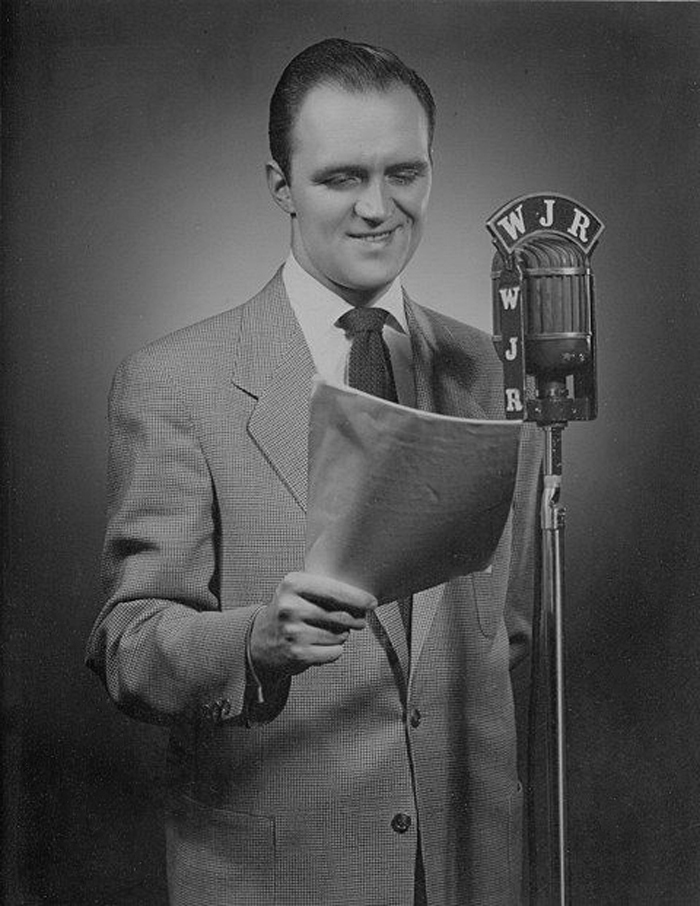
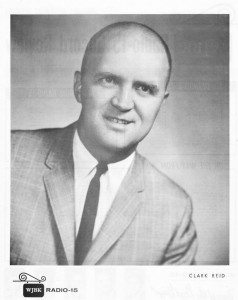
Clark Reid on WJR-AM 760 and WJBK-AM 1500 (Click on for audio play)
…Well, Jimmy Durante is still funny — television, they got them every place you go. No one listens to radio anymore. You sit in saloons and watch television. …
A long time ago in the early 1950s, there was WJR. And then there was WJBK. And there he was. Clark Reid earlier on WJR and later on WJBK radio here in Detroit.
Clark Reid. A name as enigmatic as WJBK. A name as synonymous as to what classic Detroit radio was all about, as it were, during the 1950s through the early 1960s here in the Motor City.
Clark Reid introduced himself to Detroit radio way back in 1952, when he first opened the studio microphones on local CBS-affiliate WJR. New in town at the time, Clark made his way north into Detroit from Akron, Ohio. Formerly from Akron’s WAKR, Clark once held the distinction of having replaced the legendary Alan Freed on that station, who moved over to Cleveland’s WJW to launch his legendary “Moondog” shows.
At WJR, Reid was first hired as a personality for the all-night show. While the station’s day-part policy was strictly delegated sustaining CBS network programming and local community fare, Clark was given complete control and freedom in selecting whatever music he wanted to play, so long as it was from the extensive record library at WJR.
One of the highlights of his early days at WJR was on Thursday nights when Reid was doing his “all-request” shows. With the station’s towering 50,000-watt signal, letters of requests would pour in from all over the country. It was “an important show to get a record played on,”Clark once said, as he was constantly “chased by not only by record promotion men, but also the ‘song pluggers.'”
Many of the recording stars who performed in Detroit clubs during those days found their way into the WJR studios. Some of the most popular artists became over-night “guests” on his all-night shows. It was of no consequence that on any particular night, names such as Sammy Davis, Jr., Johnny Ray, Nat King Cole, Rosemary Clooney, Eddie Fisher, Peggy Lee and many others appeared courtesy his shows, which Clark once described as resembling a “Tonight Show” on radio, for the most part, during the four years he was there. Clark recalled once that, “it was just a great experience on WJR because I had complete freedom to do whatever I wanted to do.”
But in late April 1956, Clark Reid made the switch over to WJBK for the morning drive.
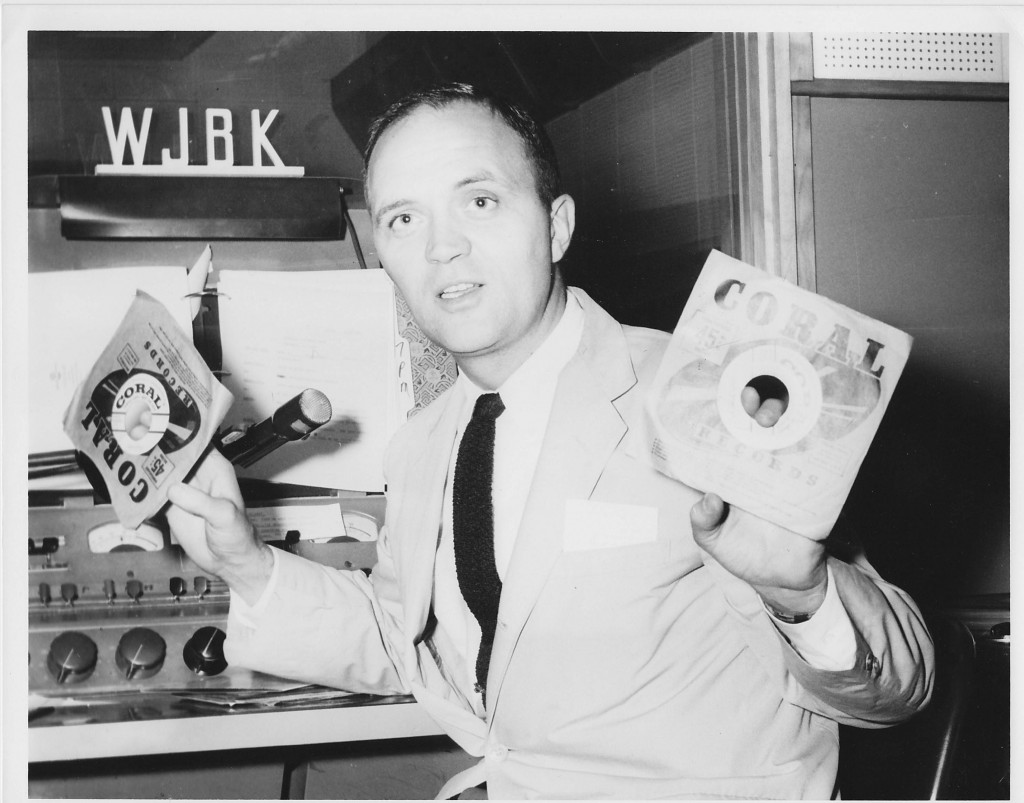
Clark was hired from WJR by WJBK Station Manager Harry Lipson immediately after WJBK fired Mickey Schorr, Schorr eventually found his way over to market-competitor WXYZ. At the same time, WJBK decided to move their morning team of Joe Gentile and Ralph Binge for the evening hours instead, while Clark Reid took over reigns as the new host for the morning show on Radio 15.
When he began his early tenure at WJBK, Reid was there working alongside with the legendary Ed McKenzie. Ed McKenzie had been at WJBK since 1937. At the time of Reid’s hiring, Ed was still broadcasting under the moniker “Jack the Bellboy,” a banner McKenzie christened unto himself when he first assumed that title a decade earlier in 1945. Also at WJBK in 1956, Reid was in good company with a new deejay that was “up-and-coming” there. His name? Casey Kasem.
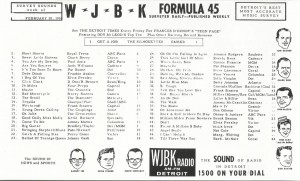
While at WJBK, the station had made the switch going with the Top 40 sound in late 1956. Their new program director, Bob Martin, changed the station’s long playlist to “Formula 45,” which became the station’s catch phrase for the music they played, not just rock and roll, Elvis and Little Richard, but also hits by the Four Lads, Perry Como, Gogi Grant and Pat Boone as well. WJBK was one of the very first major market playing Top 40 in the country then, along with sister-station WIBG, another Storer-owned station in Philadelphia at the time. Eventually, Clark Reid was given the honors hosting the “Formula 45” weekly record countdown, heard every Saturday morning on “the new” WJBK.
It was by then that Clark Reid’s sudden rise in popularity had been well established as a Motor City “favorite” on the dial. He was now center-stage on WJBK and Reid’s radio legacy would continue to flourish during the rest of his broadcasting career here in Detroit.
But after a string of successive years of Top 40 radio on WJBK, from 1956 through 1963, Detroit’s “Radio 15” was closing in on it’s best days, soon to be mirrored in it’s legendary past.
In March 1964, the impact of WKNR’s sudden rise to the top had drastically altered the market picture in Detroit. By July 1964, then in quick decline both in ratings and revenues, WJBK was no longer able to compete going against WKNR, CKLW and WXYZ as well, losing a ten-month battle to regain a larger market share. In the end, the Storer Broadcasting Company decided to dump WJBK’s Top 40 sound for a more conservative, music format they would phrase as the “Sound of (Just Beautiful) Music.”
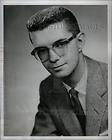
WJBK’s program director at the time, John Grubbs, stated at the time that “a majority of the people polled are desirous of the type of format we will be launching in August. WJBK’s ‘Sound of (Just Beautiful) Music and Total Information News’ is being designed to incorporate all members of the staff.”
According to Billboard’s May 16, 1964 Radio Response Rating for Detroit, WQTE and WWJ both reported conservative music formats. WCAR and WJR, meanwhile, featured music of the standard variety, culled primarily from albums played. Despite the change of format implemented suddenly at Radio 15, Grubbs was of the belief that, “our air personalities are all top pros and are capable of handling any format (changes).”
WJBK staffers included Marc Avery, Robert E. Lee, Robin Walker and Bobby Layne. And then there was “The Sound of Just Beautiful Music.” The new format change on WJBK took effect on a Sunday morning, August 16, 1964.
Many years ago, Clark had remarked in a trade article that the new format change, “came out of nowhere and I was just devastated. One day we were playing the Beatles and Motown, then, all of a sudden, they had us cuing instrumental cuts by 101 Strings.”
Apparently, the immediate music change would not bode well with Clark Reid. He would remain at WJBK for only a few more months. By early 1965 Clark had removed himself away from the station. He would journey many miles away to Cleveland’s KYW-AM. But the move to Ohio, ultimately, would be the final phase Clark would play out of his legendary broadcast career.
By year’s end in 1965 Clark Reid was back home in Detroit. But this time, as a representative for the Ross Roy Advertising in Oak Park, MI, where he culminated a very successful career with the ad agency for many years thereafter, until his retirement in 1991.
WJBK Clark Reid Jingle 1962
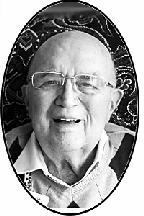
On February 3, 2012, Clark Reid passed away at his home in Novi, MI., surrounded by family. He is survived by his wife Barbara, his wife of 63 years; children Cathy, Jody, David, Libby, and Tim Reid, and his eleven grandchildren.
A memorial service was held at 11 a. m. on Saturday, February 25 at Nardin Park Methodist Church at 11 Mile west of Middlebelt in Farmington Hills.
MCRFB once again pays homage to a great Detroit radio legend as we remember . . . Clark Reid.
MCRFB would like to express our sincere gratitude to Tim Reid for donating the Clark Reid photograph (top) and aircheck for this exhibit. Clark Reid photograph and WJBK survey scan is courtesy the George Griggs collection. The Clark Reid photograph (lower) courtesy of Michigan.com.

![]()
 From the MCRFB NEWS archive: 1960
From the MCRFB NEWS archive: 1960
Jockey Clay Lays Opinion On Line; Exhorts Trade
NEW YORK — Now that the payola crises has abated, many displaced deejays have relocated — and at least one — Tom Clay of Detroit — is aggressively rooting for the old days when a disk jockey was king and could make or break a record.
In a letter to the trade, Clay (fired from WJBK, Detroit, last November on payola charges and now spinning records at WQTE, Detroit) lamented, “What’s happening to the day when we were really deejays and we would really make rounds of distribs for new records, get exited and predicted overnight smashes, make the charts instead of following them, play a record seven times in a row, and get people to buy the record the same day? So we had a little trouble in our biz. Are we going to crawl up in a shell and sit on our fat fannies and let the deejay die?”

Clay addressed special pleas to top jocks like Bill Randle, WERE, Cleveland; Howard Miller, WIND, Chicago; and Frank Ward, Atlanta. “You could tie the city in knots again,” he told Randle, “Forget teaching school. Teach the Cleveland deejays what real deejays are.” To Miller he said, “Remember when you got kicks doing shows? Are you getting too much rich making what you are doing now?”
Addressing the trio as a whole, he added, “Let’s swing again — a bunch of deejays that made their mark going out on a limb, predicting records. Now wait for it to show up on a chart… Forget your pretty voices and prestige — let’s get some excitement back in radio.”
Clay, who apparently evinces no sensitivity over his payola-headline days, concluded his letter to the trade (headed “Detroit’s No. 1 Deejay Has His Say”) with the following line: if you have any records you’d like auditioned send them. Remember, I too, was a “record consultant.” “Am I being funny? No.”
Although WQTE had said it was taking programming out of the hands of the deejays when it launched it’s new “Fabulous 56” format this June, Clay claims he is programming his own show. At any rate, he said he played Tommy Leonetti’s Atlantic waxing of “Without Love” for “45 minutes straight,” and predicted it would be “a smash hit.”
Clay exudes complete confidence in his ability to predict hits, undaunted by the fact that in a recent newsletter he informed Colonel Tom Parker that Elvis Presley’s second post-GI single was a complete bomb. The disk in questioned — released three weeks ago — is now No. 3 on the Billboard Hot 100 chart.
Meanwhile, other displaced deejays have also relocated, but are somewhat more reticent about the whole thing. Alan Freed and Mel Leeds, ex-WINS, New York program directors, are at KDAY, Los Angeles. Chuck Young, ex-KYW Cleveland music librarian, is presently working for Cosnat Distributors in Cleveland.
Stan Richards, ex-WORL, Boston, is at WINS in New York. Joe Smith, another ex-WORL spinner, is sales promotion manager for Hart Distributors in Los Angeles. Joe Finan, ex-KYW, Cleveland, is rumored to be returning to that city at WHK. Peter Tripp, ex-WMGM, New York, is reportedly set to go to KFWB in Hollywood. END
___
(Information and news source: Billboard; August 8, 1960)
![]()
 Jimmy Hampton (Taylor) on WAAM-AM (Flint), 1965; Jimmy Hampton on WXYZ AM 1270, 1966; Jim Hampton on WJBK AM 1500, 1969; Jim Hampton on WCAR AM 1130; 1970
Jimmy Hampton (Taylor) on WAAM-AM (Flint), 1965; Jimmy Hampton on WXYZ AM 1270, 1966; Jim Hampton on WJBK AM 1500, 1969; Jim Hampton on WCAR AM 1130; 1970
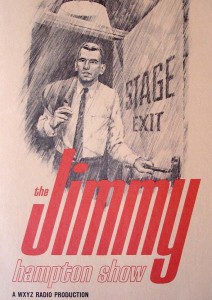
… “What happened to the record? Ladies and Gentleman, did you see this? The record is warped. What do I do now? Should I just, can we shut the station off?”….
In 1958, the legendary call letters WXYZ made an abrupt transition to swing into a new Top 40 music station for Detroit. The 5,000-watter station, new in its concept, did quite well early on battling in head-to-head competition with its rival, WJBK 1500, another Top 40 formatted station. Both WXYZ and WJBK became a dominate force in Top 40 radio in the Motor City then, as both calls would go on to impact further the local pop music scene. Both stations fared very well in their respective broadcasting community service and, it was then that WXYZ grew in radio popularity, for the most part early on during the early 1960s.
During the time WXYZ (“it’s easy to remember”) had ushered in their Top 40 era in the late-1950s through the early 1960s, by now affectionately known as “Wixie,” the station gifted the Motor City in hiring some of the best radio personalities that ever graced the radio airways in the city’s history. Some of the legendary 1270 notables at the time included these great names: Fred Wolf, Paul Winters, Lee Alan, Dave Prince, Joel Sabastian, Steve Lundy, Fred Weiss, Don Zee; and, for a short time in 1966, Joey Reynolds and Jim Hampton.
A native of Michigan, Jim Hampton grew up in Farmington and attended Farmington High School. Hampton honed in on his deejay skills early on by emceeing record hops at Farmington High, as added entertainment right after the school’s basketball games.

Immediately after graduating high school, Hampton was hired at WXYZ as a ‘record spinner,’ spinning records and filling in commercials while assisting as board-op for Paul Winter, Lee Alan, Joel Sabastian and Dave Prince. According to Jim Hampton, that given opportunity ultimately became “such an amazing experience having to work with some of the best talents in broadcasting. All of them became my mentors, particular Dave, Joel and Lee.”
While greatly appreciative of his limited capacity in radio at WXYZ with a sense of purpose and desire to go well beyond, he landed his next radio job as a deejay “weekender,” which Jim described was located “in the middle of a cow pasture,” at Ypsilanti’s Top 40 station WYSI (presently WSDS).
Having gained further radio fortitude and experience while at WYSI, Hampton’s next stop will be Flint’s own WTRX. In November of 1963, he ultimately was hired as a full-time deejay there by the station GM, who was also responsible giving him the name Jim Taylor as well.
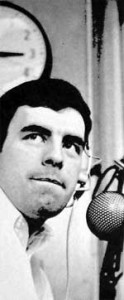
According to “Jim Taylor,” eventually, Hampton’s tenure “at night was the number one” show during the evening hours he was on WTRX. Ever so popular in the Flint area, Terry Knight was already there at the Top 40 station when Hampton was hired at the time. Hampton’s and Knight’s popularity came to full prominence during the times they both shared together on WTRX.
In 1964, Jimmy prematurely left WTRX, having quit by having thought he had a new position lined up with his former first radio love, WXYZ in Detroit. The position open at WXYZ was granted to someone else instead, and Jim found himself without work. WTRX immediately filled his position there with Larry Morrow, who later would come to prominence as Duke Windsor on CKLW.
Moving on to Jackson, Michigan. Jimmy applied and was offered a radio position with WKHM, another Knorr Broadcasting station in Michigan at the time. According to Jim, that was short-lived, as he decided to make that daily long travel there from Farmington to Jackson, a travel prospect having proved difficult, as he recently described to mcrfb.com.
And so it’s back to Flint one more time. But this time it’s on WAMM with the afternoon drive. Now with dual duties there, Jim accepted the initial offer to be the station’s music director as well.
A year goes by. By early 1966, Jimmy Hampton finally gets that call he was waiting for. Lee Alan, program director at WXYZ radio at the time, was on the horn with Jim. That call, as Hampton related, for him, “it was a dream come true.” And Jim Hampton was only every bit nineteen-years of age.
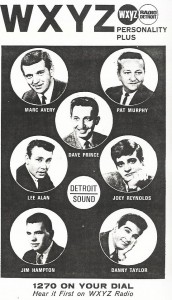
When that call was made, the ABC-owned radio station was the gold standard for broadcasting here in Detroit. Very prestigious in the field, WXYZ also was a television-affiliate and, as Jim Hampton had disclosed, the pay was above respectable for those who were hired to work for “Broadcast House,” located in Southfield. He disclosed his pay in 1966 at $165.00 a week, roughly $60,000 in today’s inflated money standards. In contrast, Joey Reynolds, the anticipated radio star WXYZ also hired in 1966, earned roughly “$325.00 per week” during the few months he was briefly there. Not bad.
But unfortunately, the “good times” would suddenly come to an abrupt end at “Wixie” radio. While still serving in the U.S. Army reserves, Hampton was called for active duty in late 1966, and would serve into the early months of 1967. During the six months he was away, changes were on the horizon that year for WXYZ. By the time he returned from the reserves, WXYZ dumped the Top 40 format for middle-of-the-road “beautiful music” instead, aptly christened as “The Good Life.” Lee Alan was gone by then, and while Joe Bacarella was now at the helms, Johnny Randall was hired to fill the void Hampton had left open during the time he was on reserve active duty. In the meantime, Jim filled the rest of his time on WXYZ-FM for the “obligatory six months after doing service.”
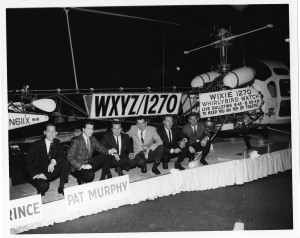
Once again in search for higher ground, in late 1967, Hampton was introduced by a fellow radio acquaintance to John Detz at underground-rocker WABX-FM in Detroit. He was hired for the afternoon drive. About the same time, Jim recalled he got a call from KQV in Pittsburgh. He was offered an on-air position from Mike McCormick, who was the program director at the ABC-owned Top 40 station there. “I couldn’t see myself in Pittsburgh,” Hampton recalls, “but I ultimately got off the air and instead became co-manager of sales at WABX-FM.”
Having set up the new sales department for WABX, Hampton was instrumental in hiring Jim Irrer and Richard Golden for the sales team. Jim went on to say, that, “they became legends and made the station very successful with advertising.”
During his stay at WABX, another radio opportunity was left open for Jim. Late in 1968, there had been talk in the trade that WJBK was soon dropping it’s “beautiful music” format, planning it’s return to Top 40 radio in 1969 for the 50,000-watt daytimer (WJBK’s transmitted-power dropped down to 10,000 watts at night).

The new 1969 WJBK lineup were to include Marc Avery, Conrad Patrick, Hank O’Neil, K.O. Bailey and Tom Dean. Jim Hampton was asked to join the team. He became the music director while doing the all-night show once again. But the format would bomb within a few months after its inception on WJBK. Instead, WJBK decided to go with country. As the rest the lineup goes, Jim found himself out of radio one more time.
But Jim’s radio career was far from over. Ken Draper, the legendary radio programmer who created WCFL in Chicago, was coming to Detroit’s WCAR. Jim’s meeting with Draper went well. He was hired as WCAR’s Production Director. It was a first for Jim, as he said this opportunity “really honed my skills as a producer and writer, which helped me later when I went to LA to become a producer for syndication. WCAR was an amazing station at the time with names like Ray Otis, Specs Howard, Dave Prince, H.B. Phillips, Dan O’Shea, Warren Pierce, Edward Alan Busch to name a few.”
Now nearing the end of 1969, Jim was getting a little restless with the Detroit radio market. The news director at WLS in Chicago, Phil Hayes, an old friend of Jim’s, decided to give him a call. He said Mike McCormick, the new PD, who previously invited Jim over to Pittsburgh’s KQV a few years back, was now looking for a new Production Director for the legendary Windy City station. Jim and his wife decided to leave Detroit that weekend and headed straight for Chicago. After having met Mr. McCormick during an outdoor social event, and “after a few drinks,” that same night, Jim agreed to accept the offered opportunity to work for WLS.

In the ensuing years after his last radio stint at WLS in Chicago, Jim Hampton’s career in broadcasting excelled to greater heights with syndication marketing. While in LA perfecting his craft in production writing and radio syndication, Jim produced over 1,000 specials for the ABC Radio Network and has interviewed many musical stars for radio affiliates across the nation and around the globe as well. Many would include various recorded specials for national distribution home and abroad, including The John Lennon Story, The Bob Seger Story, The Beach Boys Story, The Eagles Story, Michael Jackson, Super ’70s and much, much more.
Today, Jim Hampton resides in the Los Angeles area. But his heart never abated no less the love he always held for the city he affectionately still calls home. A winner of the Aegis and Telly Awards, currently he is CEO of Greenhouse Marketing Group, a marketing and sponsorship sales company that represent many organizations, events and broadcast properties across the United States and worldwide.
MCRFB would like to express our sincere gratitude to Jimmy Hampton for contributing to this exhibit. All photos courtesy of Jim Hampton. We also would like to thank Jim for permitting this website to exhibit his sensational twelve-hour radio special “Radio Recall,” which Jim locally produced for WPON-AM in Pontiac, Michigan for the 2009 Memorial Weekend.
On behalf of George Griggs, Scott Westerman and mcrfb.com, Jim Hampton, thank you so much for sharing once again those wonderful Detroit radio memories you gave us all.
From the MCRFB Aircheck Library, featuring:
(Click on name for audio)
WAMM-AM 1420 (Flint) Jim (Taylor) Hampton 1966
WAMM-AM 1420 (Flint) Jim (Taylor) Hampton w/Stevie Wonder 1966
WXYZ-AM 1270 Jimmy Hampton August, 1966
WXYZ-AM 1270 Jimmy Hampton 1966
WJBK-AM 1500 Jim Hampton 1969
WCAR-AM 1090 Jim Hampton 1970
Addendum (Update): Special thanks once again to Jimmy Hampton for sharing with MCRFB the photos below, added to this exhibit September 8, 2012.
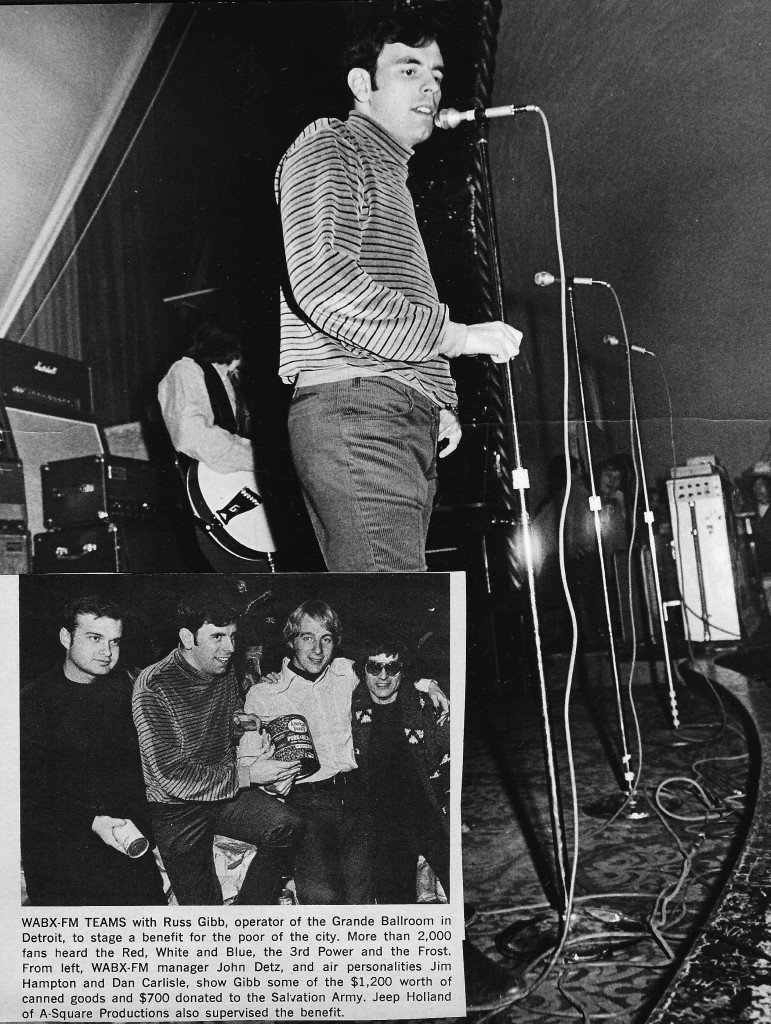
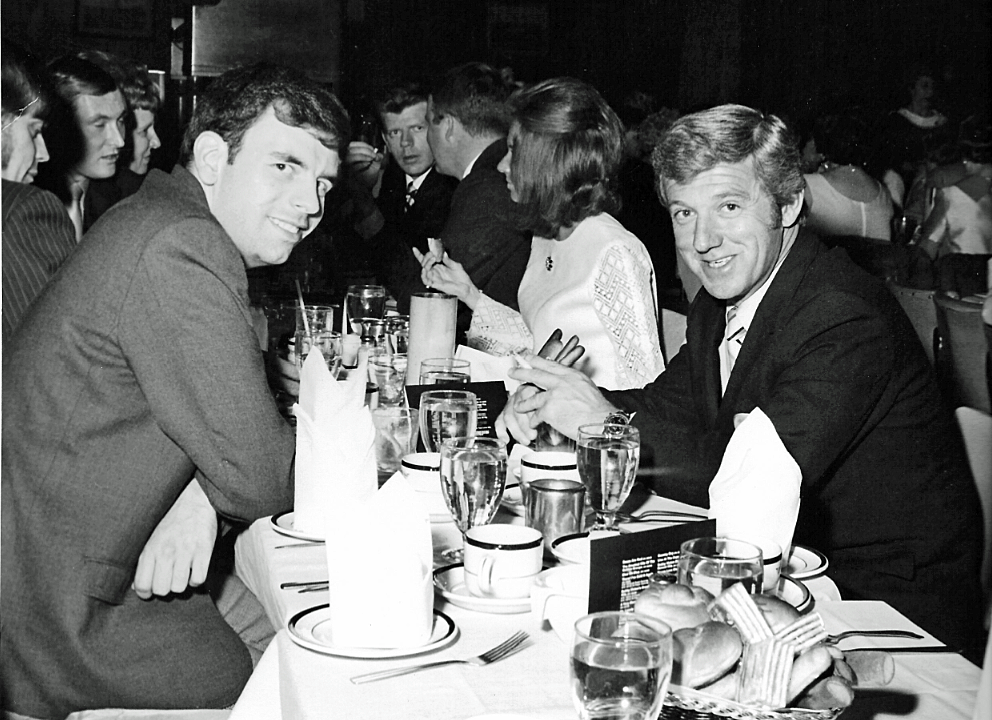
![]()
 From the MCRFB news archive: 1964
From the MCRFB news archive: 1964
WJBK SWITCH FROM ROCK TO CONSERVATIVE MUSIC FORMAT
DETROIT — The Motor City will soon lose it’s distinction of being the only city in the U.S. with four full-time contemporary music formatted radio stations.
WJBK, the Storer-owned station, will drop its rock-pop music format on August 16 in favor of an all album, conservative music format.
The post-TV situation saw a battle for the pop market between WXYZ, the ABC-owned outlet, WKMH, with Robin Seymour leading the way, and WJBK.
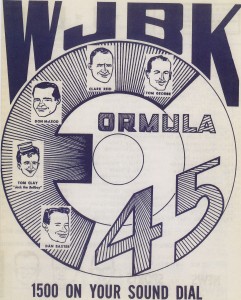
Six or seven years ago, the 50,000-watt CKLW, just across the Detroit river in Windsor, began to feature a younger deejay lineup and playing more of the top current pop singles. The RKO General station with its big wattage has been effective carving an important niche for itself in the Detroit market as well as in secondary markets in Ohio, Michigan and Indiana.
The next significant important change in the contemporary station line-up was the switch of WKMH to a standard, no rock policy, leaving the field to WXYZ and WJBK, with CKLW contributing its share to the hot pop scene, but not to the same degree.
Enter WKNR
The most exciting change to the status quo took place in November of last year, when WKMH pulled a complete 360-dgree switch in music format and call letters, WKNR, came a 30 plus 1 contemporary music format, promotions galore, much fanfare in the press and also added a few new swingin’ airman to enhance the format change.
The impact of WKNR greatly altered the Detroit market picture, rating-wise and pop-music wise. The tight-playlist formula the station’s concentrated on and off-the-air promotion drove the station’s ratings from obscurity up to a position of prominence.
Although many factors must be taken into consideration in reasoning why a station decides to change it’s format, many programmers label any format changes as a certain sign of defeat. Industry observers opinion that the mitigating factor in the forthcoming WJBK change was brought on by the impact of WKNR on the market, along with the solidifying of WXYZ’s influence on its pop music audience and coupled with the increased competition in the same area from CKLW.
Other important factors to be taken into consideration is the affinity of the Storer Broadcasting Company for conservative and subdued music formats. WJBK will, along with WGBS, Miami; WHN, New York City; WJW, Cleveland and KGBS, Los Angeles, be programmed musically from Storer’s music department in Miami.
At present Storer’s 50,000-watt station in Philadelphia is the company’s foremost and highly successful exponent of contemporary music. Another tpo-rated Storer station, WSPD in Toledo, also features a pop music, news and personality format.
Current Research
WJBK is presently in the survey of the listeners in Wayne, Oakland and Macomb counties to keep in touch with their taste, desires and preferences in radio.
“Although we have only completed approximately half of the current survey, we are learning that the majority of the people polled are desirous of the type of format we will be launching in August,” said John Grubbs, WJBK program station manager.
According to Billboard’s May 16 Radio Response Rating for Detroit, WQTE and WWJ reported conservative music formats. WCAR and WWJ features music of the standard variety, culled primarily from albums.
“WJBK’s ‘Sound of (Just Beautiful) Music and Total Information News’ format is being designed to incorporate all members of the staff,” said Grubbs. “Our air personalities are all top pros and are capable of handling any format.”
WJBK staffers include Marc Avery, Clark Reid, Robert E. Lee, Robin Walker and Bobby Layne. Grubbs scotched rumors circulating in the trade in recent weeks that he is being transferred to WIBG in Philadelphia as program manager replacing William Wheatley.
“The rumors circulating to the effect that I am being moved to WIBG or any other station are not in any way based on fact,” emphasized Grubbs. END.
(Information and news source: Billboard; August 1, 1964)
![]()
FROM WKMH TO WKNR, FOUR-WAY BATTLE HEATS UP RADIO DIALS ACROSS DETROIT
DETROIT — A four-way battle is shaping up in this market with the immediate changeover in programming at WKMH.
The Dearborn-based 5,000 watter has introduced a new set of calls, WKNR, several new deejays, and a radical switch from the soft sound in music to a “30 plus 1” format. Detroit will be one of the few markets where severe competition is taking place among three or more pop music stations.

The Knorr-owned radio outlet has been under the programming consulting of Mike Joseph for many months. Soft standards have been the path for more than a year. WKMH (now WKNR) was once the major pop music outlet in the market. Today a major fight is now developing between the new WKNR, RKO radio’s 50,000 watter, CKLW, WJBK, Storer-owned “teen’s swinger” radio, and WXYZ, the ABC-owned pop-rater on the 1270 radio dial in Detroit. Recently CKLW had added Tom Clay in the afternoon-evening drive to help accentuate CKLW’s positive pop sound.
Mort Crowley, a KHJ defector, broadcasts 5 to 9 a.m., followed by the former-WKMH mainstay Robin Seymour in the 9 to 12 p.m. time slot. Jim Sanders is handling the noon to 3 p.m. shift, and Gary Stevens will be hosting the 3 to 7 p.m. segment. Bob Green will deejay from 7 to 12 a.m., while Bill Phillips will hold down the fort all night long until 5 a.m. END.
(Information and news source: Billboard; November 16, 1963).
![]()
TV Disk Hops Hit In Detroit
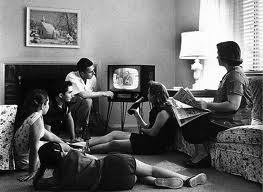
DETROIT — WJBK-TV has come up with ample evidence of current audience popularity for afternoon “bandstand” formats of programming records on TV for dancing by a live studio audience of teenagers.
The Detroit television station pulled a special ARB survey of its new “Detroit Bandstand,” emceed by Dale Young from 5:00 to 5:30 weekdays, and came up with a whopping 14.8 share in viewer ratings in the Detroit-TV market during the afternoon time period. The ratings were double its nearest competition, “Superman.”
Reacting to the ratings surprise, WJBK-TV added a Saturday segment of the “Detroit Bandstand” show at 5:00 to 6:00 p.m. The station claims that 4,000 pieces of mail came in during the show’s first week.
Hopping On The Hop Wagon
Stations in other markets have added record hops to their TV schedules, a major impetus being the success of Dick Clark’s ABC-TV network strip. As recently as WJBK-TV in Detroit, now KBTV, Denver, has taken the logical step of programming its new “Denver Bandstand” in and around Dick Clark’s show, so the teenagers will be dancing to local disks for 30 minutes, followed by Clark, returning to the local show for one hour. Up until now, stations have been programming directly opposite Clark or as far away from him on the clock as possible. END.
(Information and news source, Billboard Magazine; April 14, 1958).
![]()
 Canadian Girl Singer Hails from Richmond Hill, Ontario
Canadian Girl Singer Hails from Richmond Hill, Ontario
S A N D Y S E L S I E .
IF YOU WERE TO DO A SEARCH on the world-wide web, not much information can be found on the Internet today regarding, Sandy Selsie.
All that has been primarily known about Sandy Selsie was that she had several country/pop singles in the early-1960s on the Columbia record label. And that she originally was from Canada. And that’s just about it.
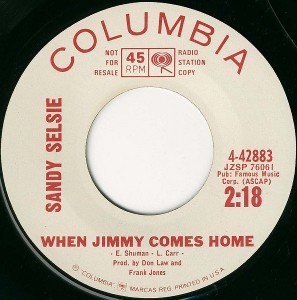
But there was a detailed mention about this female Canadian artist on a Yahoo message board, which I recently found on the Spectropop blog site message forum.
A poster there, who goes by the name of “Boris” laid claims he resides in Ottawa, Ontario in Canada. An avid record collector on “girl/girl groups” since the early-nineties, and in researching Canadian recording artists, he stated he once had gone to the Canadian National Archives library and came across a newspaper article on Sandy Selsie, which appeared in the local Richmond Hill, Ottawa newspaper called The Liberal.
Accordingly, the article first appeared in 1963. The article had stated Sandy Selsie hailed from Richmond Hill, Ontario, now a large suburb outside of Toronto.
Back in 1963, according to The Liberal article, Sandy Selsie was a grade 10 student who attended Bayview High School in Richmond Hill, at the age of 15. Her father, Fred Selsie was her talent-manager during that time. Mr. Selsie was instrumental in signing a 5-year contract for Sandy with Columbia Records earlier in 1961. Her first recording for the label was, “A Date With Loneliness” which was released in November of that year.
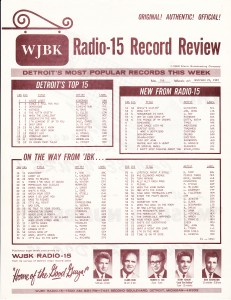
The article quoted Sandy Selsie as stating how her career came into prominence early-on. “I started out singing in the area shows. And gradually branched over to radio and television. I’ve had guest spots on the Country Hoedown television show as well as appearances on the Tommy Hunter radio show.”
The article also stated her big break happened when the family took a vacation down to Nashville, Tennessee, early in 1961.
“We were down there on our vacation. And we decided I should drop in to Columbia Studios for an audition.” She was signed immediately. “I was really surprised, because it’s unusual for a big recording studio to sign you just like that.”
In closing the article, Sandy Selsie expressed her desires in pursuing a Major in Performing Arts.
On a small note, as it were, Columbia Records initially released Sandy Selsie’s “When Jimmy Comes Home” in November, 1963. The song debuted on the CHUM playlist early-on in November in Sandy Selsie’s own home-town. Just the same, the song would find it’s way over to CKEY 580 AM in Toronto about the same time-frame.
Locally, the Selsie song made it’s way over here on Detroit radio, “When Jimmy Comes Home” debuted first on WJBK Radio 1500 on Friday, November 15, 1963.
Six days later, it debuted at the #30 spot on the WKNR Keener 13 playlist for Thursday, November 21, 1963. On a local level, the song didn’t stay long on the charts here in Detroit. But after having first heard it played on WKNR late in 1963, personally, this Sandy Selsie classic will always be a great Keener song memory from that year.
While certainly there weren’t too many, this long forgotten, obscure song as was recorded by Sandy Selsie, arguably, may well have been the greatest “Jimmy” song that was ever recorded in the Top 40 era.
— M O T O R C I T Y R A D I O F L A S H B A C K S
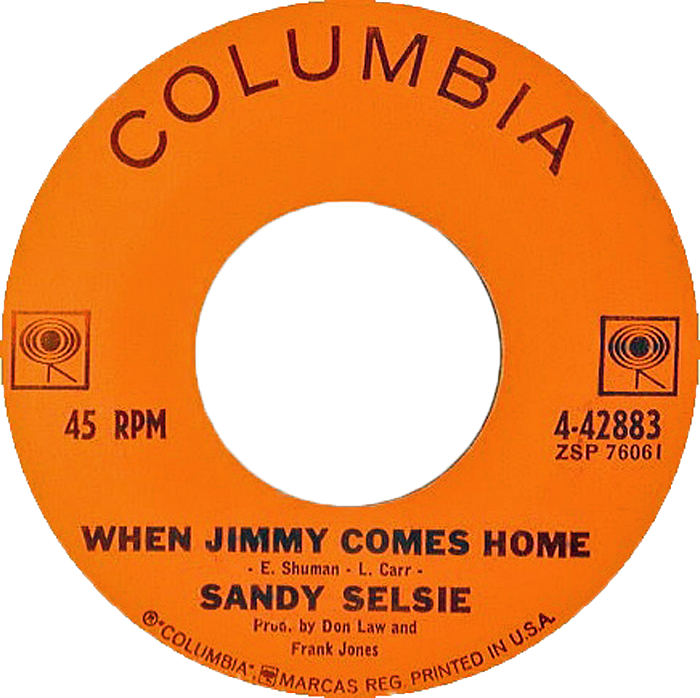

![]()